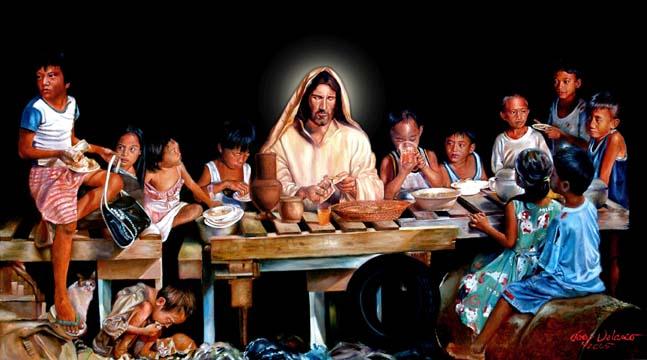 [/caption]
[/caption]Joey Velasco is a Filipino artist who gave so much hope to the lives of those street children he painted in his famous Hapag ng Pag-asa....
Why Hapag ng Pag-asa?....Joey Velasco was moved by his work that he made great efforts to help those street children he used as models in his painting....At first he just used them as his models , but God knocked on his heart and he searched for them, fed, and clothed them ...Now they have been sheltered by Gawad Kalinga....an organization helping people suffering from poverty....Here is an excerpt from the book...."They Have Jesus" written by Joey Velasco....
They Have Jesus
| Foreword (by Cardinal Rosales, Archbishop of Manila) A dinner table reveals a lot about hunger, manners and relations. Who sits near the host, who serves the guest or who cares for the youngest, all these are made known at the family dinner. More than taste, meanings are associated with what one eats or even on how one sits at the table. Friendship, old ties or the loss of it are suddenly recalled when diners meet, and the passing of food is enriched with stories and sharing of familiar knowledge and feelings. Surprisingly some meals are taken hurriedly, thus crumbs fly and the meaning of the coming together is lost. In the Israelites’ flight to safety at the night of the great escape (Exodus) the surprise of running away left the people with many experiences unexplained; symbols were lost, as people fled in fright. Thus many more meals will be celebrated in order to get to the meaning of their paschal meal. And “one of your children will ask you, what does this ritual mean?” Tell us that some meals have become so private and solitary that no one asks a question? What do we eat? Where’s the patis? Who’s coming to dinner? The art of conversation and telling stories has already been lost at many dining tables. More than enjoying a repast, a diner has need to reveal other wants. Every child diner at the hapag reveals a story of more hunger than a plate of rice could satisfy. Onse, a nine year old lad, for example sits at the hapag ng pag-asa, his plate cleaned to the last crumb, but he listens still to feed his other hungers as a cart-pushing scavenger whose father is a drug addict and the mama is a club strip dancer. At the table of the Master, Itok, the eleven-year old bread winner, another cart pushing scavenger, whispers that he has gone number of times to jail after having been caught in a number of thieveries. What hunger and desires did this talented scavenger bring to the feet of Jesus and those who believe in Jesus? A Christian community is fittingly disturbed as it watches the masqueraded struggle between good and evil, between wealth and poverty, between greed and compassion, power and weakness as played in the lives of these children robbed of innocence and security of an ordinary growing youth. Around the table were young people, including one whose hurt dug deep into her heart and completely erased whatever dignity a young girl had. Much misery is hidden behind the faces of the hapag children whose lives are further shrouded in the destitution of cemetery shack-dwellers and pushcart lodgers. Is the hapag still waiting for food, or are the poor young diners announcing a different hunger that makes young and old, rich and poor, the educated and the ignorant equally famished for nourishment that only love could satisfy? The artist Joey Velasco’s portrait of the young asks us more questions about ourselves rather than probe the hapag children. Rather than ask “why” these young people live in such an unkind and violent world, the challenge to the beholder of the portrait should be “how” in a Christian community the poor children could be helped out of such misery. Pope Benedict XVI in his first encyclical letter, DEUS CARITAS EST, reminded us that the essential core of communion, at the heart of love, remains the same: “within the community of believers there can never be room for a poverty that denies anyone what is needed for a dignified life”. (DCE, 20). The hapag is not an accusatory portrait. But the reality of the shacks under the bridges and the tunnels of homes along esteros, or the slums among the tombs from which many more young ones come, challenges every believer in the Christ who loves the poor. “How” can we be Christians to them? Can a good Christian, a true lover of Jesus, be without compassion for the poor? Welcome this portrait into your own and make the dining table serving life not just a table of hope, but isang HAPAG-IBIG or hapag ng pag-ibig. In addition the book was entitled "They Have Jesus" because Joey Velasco was inspired by one who viewed the painting and said to him that "No they weren't actually unfortunate or miserable....They have Jesus.", this viewer had said to the artist.... Blessed are the poor in spirit for they shall see God..... |
No comments:
Post a Comment